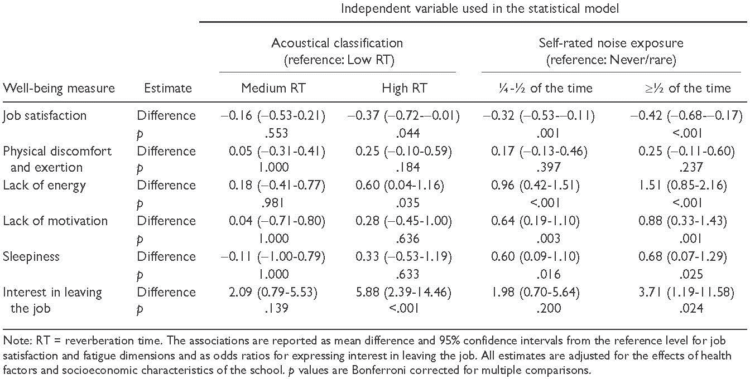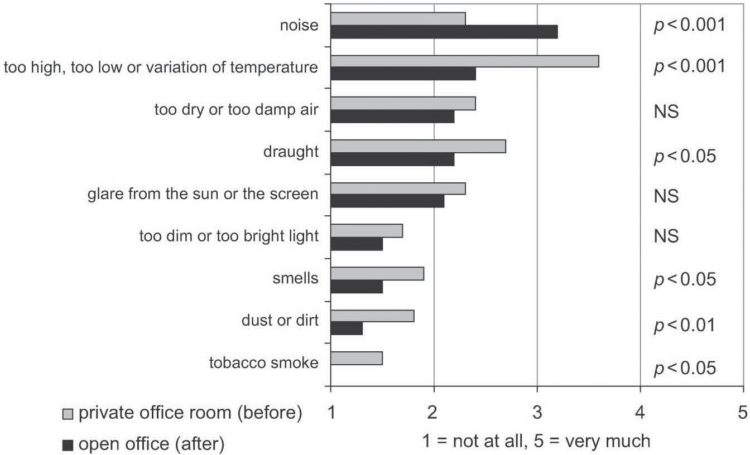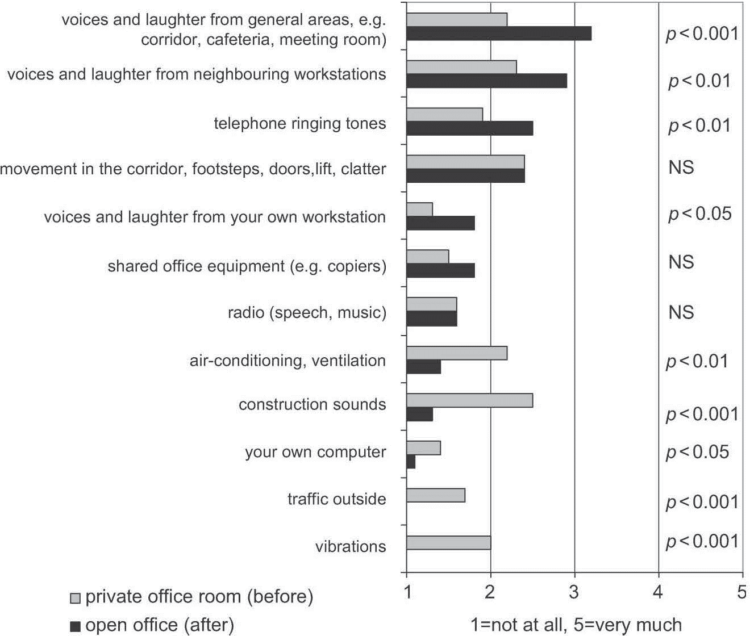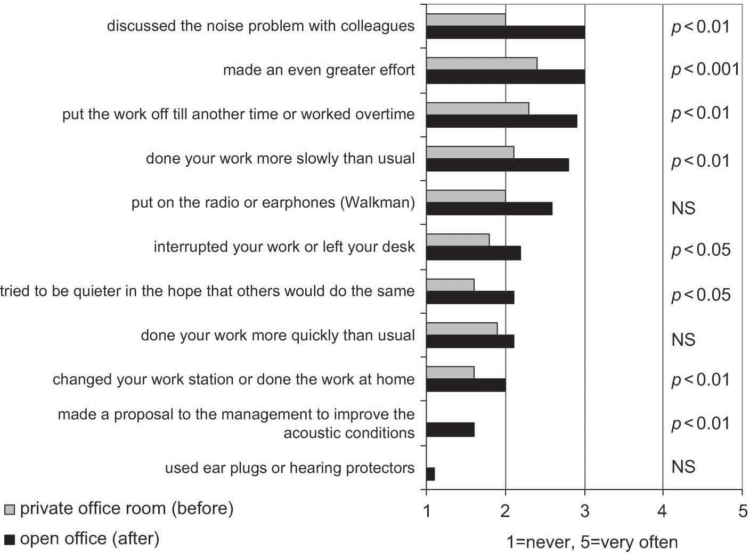June 9, 2020
Acoustics + Performance
Acoustic - Performance Research Brief
Summary
Acoustics have a dramatic impact on performance of workers, students, and instructors through distraction, poor concentration, and speech inaudibility. Satisfaction is diminished since these issues can compound and lead to employee loss. Regarding open-office plans, productivity and satisfaction can be diminished, but research shows that employees prone to these characteristics will exhibit them regardless of the environment.
Overview
I. Reduced Noise Levels
Improved acoustics contribute to decreased strain on staff, facilitating an increased capacity to care for patients. It seems likely that improved acoustic conditions in the healthcare environment also reduce risks of conflicts and errors (Blomkvist 2005). Literature reviews suggest that “reduced noise and distractions” contribute to reducing errors in medication preparation (Joseph 2015, 1207). Lower noise levels have been connected to numerous positive benefits on hospital staff, including “reduced perceived work demands, increased workplaces social support, improved quality of care for patients, and better speech intelligibility (Ulrich 20014, 5). In a classroom setting, “Very good” acoustic treatments give high absorption of noise with high “speech intelligibility”, so neither students nor instructors have to speak louder or repeatedly to their audience over short distances (Tiesler 2015).

Base Noise Level observed in classrooms over all lessons conducted in the morning. Data reflects instructors reported Bad (grey) and Very Good (maroon) room acoustics (Tiesler 2015).
II. Increased Noise Levels
Noise has been shown to decrease performance of tasks involving writing and math, particularly from speech noise. Additionally, “complex tasks that demand intensive concentration and cognitive capacity suffer more than simple, well-rehearsed motoristic tasks”. However, it hasn’t been shown to disrupt the performance of “cognitively demanding tasks such as planning, creative work, and compiling.” Problems with concentration seem to arise with greater noise because “irrelevant sounds impair cognitive performance by breaking through selective attention” (Kaarlela-Tuomaala 2009, 1439). Coping strategies for dealing with increased noise in office environments, such as leaving one’s desk, switching workstations or working more slowly also contributed to a “direct loss of work performance”. Several studies have reported that most office workers survey have found“ concentration being impaired by offices sounds such as unanswered phones and background speech”. Poor acoustics can also “lead to dissatisfaction with the office environment and can affect workers’ performance”. For tasks involving reading or writing, the similarity of nearby speech with material being worked on has been found to relate to the amount of disruption (Kaarlela-Tuomaala 2009, 1439).
“The intelligibility of speech seems to be a crucial factor” in acoustic disturbances and “increasing the difficulty of a given task”. “People complain more when clear and distinct voices can be singled out from an ambient babble”. Tasks such as phone conversations are particularly prone to disruption due to the increase of irrelevant speech noise and the difficulty talking without raising one’s own voice. This suggests that both the intelligibility of nearby speech and volume influence the level of distraction. Additionally, studies implicate conversation and phone noise as the two highest factors relating to annoyance and decreased productivity (Mak 2012, 343).
III. Classroom Performance
Experiments showed that children whose classrooms had long reverberation (RT_3) performed worse than children from classrooms with short reverberation (RT_l) on a phonological processing task involving identification, storage, and phonological analysis of spoken words or nonwords. In addition to lower performance, children whose classrooms had long reverberation reported a higher burden of noise in the classroom and judged the relations to their peers and teachers less positively when compared to children from classrooms with short and medium reverberation (Klatte 2010 673, 676). Reverberation time as well as noise exposure had an effect on job satisfaction, lack of energy, and interest in leaving the job for school teachers (Kristianson 2013, 292).
Chronic exposure to both external and internal noise has a detrimental impact upon the academic performance and attainments for students. For external noise it appears to be the noise levels of individual events that have the most impact while background noise in the classroom also has a significant negative effect. Older primary school children, around 11 years of age, appear to be more affected by noise than the younger children. In order to minimize the impact of noise upon children at school it is therefore necessary to consider two factors. The siting and the internal layout of a school should be such that classrooms are not exposed to high levels of noise from external sources such as road traffic, railways, or aircrafts. In addition it is essential to minimize background noise levels in the classroom to ensure that optimum conditions for teaching and learning are achieved. It has been found that the negative effects of environmental noise are long term (Shields 2008, 142).

Effects of acoustic classification and noise exposure on Well-Being Indicators (Kristiansen 2013).
IV. Open-Plan Offices
Open-plan offices have higher rates of noise disturbance than private offices. Exposure to office noise negatively impacted ratings of adverse perceptions, selected symptoms, and self-assessed performance, but not necessarily the performance of office tasks. Occupants who in their daily work were disturbed by open-plan office noise responded differently to noise than those who were not (Toftum 2012, 6).
However, noisiness of open-plan offices is not an intrinsic quality. Time-averaged SPLs over the working day were practically the same in both office types. This disagrees with general judgements, according to which open-plan offices are noisier than private offices. Noisiness is a subjective descriptor but a noise level meter does not seem to be the most appropriate tool for its assessment in different office environments (Kaarela 2009, 1437).

How much have the following indoor environmental factors disturbed you at your workstation during the last 3 months? Mean values and the significance of change (p-value) (Kaarela 2009).

How much do the following sounds disturb your concentration on your work at your workstation? Mean values and the significance of change (p-values) (Kaarela 2009).

How often do you act in the following way to cope with your work because of the sounds in your work environment? Mean values and the significance of change (p-value) (Kaarela 2009).
VI. References
Review Articles
- Blomkvist, Vanja, Clair Anne Eriksen, Töres Theorell, Roger Ulrich, and Gundars Rasmanis. “Acoustics and psychosocial environment in intensive coronary care.” Occupational and environmental medicine 62, no. 3 (2005): e1-e1.
- Kaarlela-Tuomaala, A., R. Helenius, E. Keskinen, and V. Hongisto. “Effects of acoustic environment on work in private office rooms and open-plan offices–longitudinal study during relocation.” Ergonomics 52, no. 11 (2009): 1423-1444.
- Klatte, Maria, Jürgen Hellbrück, Jochen Seidel, and Philip Leistner. “Effects ofclassroom acoustics on performance and well-being in elementary school children: A field study.” Environment and Behavior 42, no. 5 (2010): 659- 692.
- Kristiansen, Jesper, Roger Persson, Søren Peter Lund, Hitomi Shibuya, and Per Møberg Nielsen. “Effects of classroom acoustics and self-reported noise exposure on teachers’ well-being.” Environment and Behavior 45, no. 2 (2013): 283-300.
- Mak, Cheuk Ming, and Y. P. Lui. “The effect of sound on office productivity.” Building Services Engineering Research and Technology 33, no. 3 (2012): 339-345.
- Mehta, Ravi, Rui Zhu, and Amar Cheema. “Is noise always bad? Exploring the effects of ambient noise on creative cognition.” Journal of Consumer Research 39, no. 4 (2012): 784-799.
- Shield, Bridget M., and Julie E. Dockrell. “The effects of environmental and classroom noise on the academic attainments of primary school children.” The Journal of the Acoustical Society of America 123, no. 1 (2008): 133- 144.
- Tiesler, Gerhart, Rainer Machner, and Holger Brokmann. “Classroom Acoustics and Impact on Health and Social Behaviour.” Energy Procedia 78 (2015): 3108-3113.
- Toftum, Jørn, Søren Lund, Jesper Kristiansen, and Geo Clausen. “Effect of open-plan office noise on occupant comfort and performance.” In 10th International Conference on Healthy Buildings. 2012.
Primary Research
- Akbari, Jafar, Habibollah Dehghan, Hiva Azmoon, and Farhad Forouharmajd. “Relationship between lighting and noise levels and productivity of the occupants in automotive assembly industry.” Journal of environmental and public health 2013 (2013).
- Balazova, Ivana, Geo Clausen, Jens H. Rindel, Torben Poulsen, and David P. Wyon.“Open-planofficeenvironments: a laboratory experiment to examine the effect of office noise and temperature on human perception, comfort and office work performance.” Proceedings of indoor air 2008 (2008).
- Banbury, Simon P., and Dianne C. Berry. “Office noise and employee concentration: Identifying causes ofdisruption and potential improvements.” Ergonomics 48, no. 1 (2005): 25-37.
- Clark, Charlotte, and Patrik Sörqvist. “A 3 year update on the influence of noise on performance and behavior.” Noise and Health 14, no. 61 (2012): 292.
- Sykes, David M. “Productivity: How Acoustics Affect Workers’ Performance In Offices & Open Areas.” (2004).
Popular Press
- “The Optimal Office” – The Atlantic
